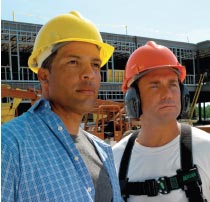Three CIHs will present a full two-hour program, including a demonstration of quantitative fit testing, for policyholders at the San Bernardino office.
One of the 10 showed how better sizing of fall harnesses could reduce injury risks of construction workers.
An awareness campaign and a series of workshops follow three fatal falls in the state this year.
Keeping pace with rapid advances in the field is necessary; the top goal is quantifying risks to workers.
The Corps had received 76,000 of the 84,000 vests it had ordered but has found its personnel don't like this design as well as the outer vests they were used to.

International sales are eclipsing North American sales for the Pittsburgh-based PPE manufacturer, which racked up an 8 percent increase in year-over-year sales.

You don’t have to go far in any city or along an interstate highway to hear the sounds of new construction— office buildings, hotels, restaurants, shopping centers, and houses. And just as you can hear the loud sounds of cranes, pile drivers, nail guns, and jackhammers, so, too, can the workers who are raising these structures. In fact, it’s a lot louder for them. Are they wearing hearing protection? In many cases, the answer is no.
Every safety program has the opportunity and responsibility to review selection, use, policy, and follow-up and to make those changes needed right now.
Few of us can imagine losing our hearing or vision, or the physical recovery from facial damage from an injury and the hardships this loss would cause to the injured or his/her family and relationships—from time, bills, and potential lost earnings alone. Yet these injuries are very common at the workplace and sometimes are shrugged off as the cost of getting the job done by employees and supervisors alike. What can we as safety leaders do to help drive home the message of always wearing appropriate PPE? And how can we keep our efforts on the front burner with upper management?
The American Industrial Hygiene Association has announced it will host "The Value of Anthropometrics," an intermediate TeleWeb Virtual Seminar on March 20, 2008, from 2–4:30 p.m. ET. This course is intended to provide an overview of fit testing, including the application of fit testing methodology to the NIOSH certification program, and provide insight into the development of the new respiratory fit test panel and an overview of fit testing results using the new panel.
The company's CEO calls it "another year of spectacular progress."
A Canadian safety center is exploring similar issues in a national survey.
The company exhibited them at a recent Moscow exhibition that attracted 25,000 attendees.
It was a model job site, each employee wearing spotlessly clean safety glasses or goggles at every workstation. (Here is where experience comes in, however. The trash cans and floors held the evidence: newly deposited wrappers from someone walking through and handing out new equipment just before the inspection!)
Fourth quarter 2007 sales were a record $6.2 billion, up 7 percent.
Two contracts worth about $30 million are being fulfilled by Nacre, a subsidiary in Norway, the company announced.
"Reliable biomechanical geometric data of the human skull can help us to better understand the problem of head injury during an impact and help in the design of better head protective devices," the researchers say.
The Selector is a highlight of the company's expanded offerings, delivering a range of recommendations for users' specific applications.
Several factors have affected the growth in the PPE market, including concern for employee safety on the corporate level; a stronger, more knowledgeable workforce than in years past; manufacturers' continued innovation; a solid economy; and the ever-important diverse customer base, the publisher says.

Head injuries tend to be most serious and result in fatalities from skiing and snowmobile accidents. While the number of skiing-related head injuries has remained about the same, the good news is that the number of snowmobile-related head injuries has decreased considerably in the last two years.